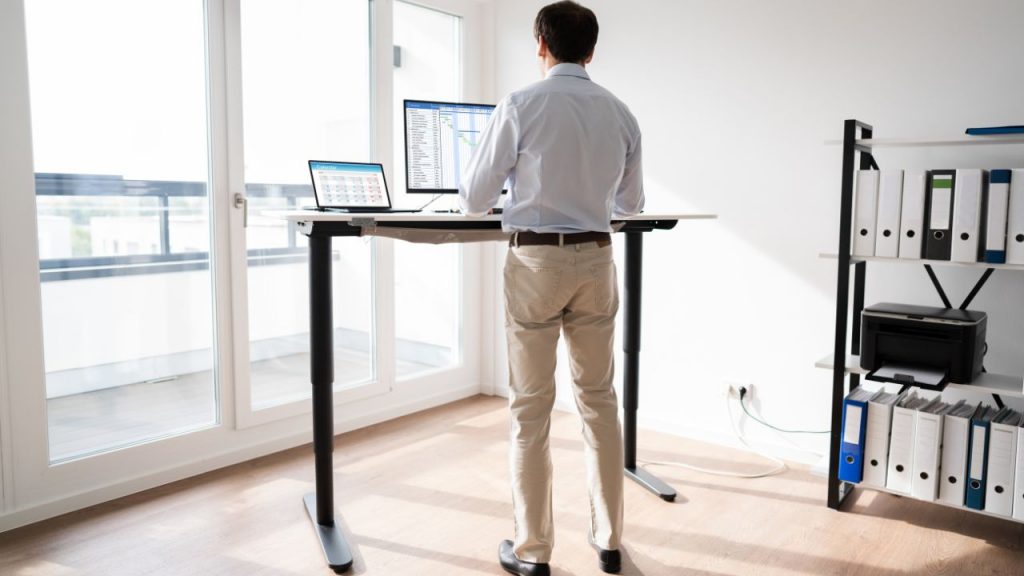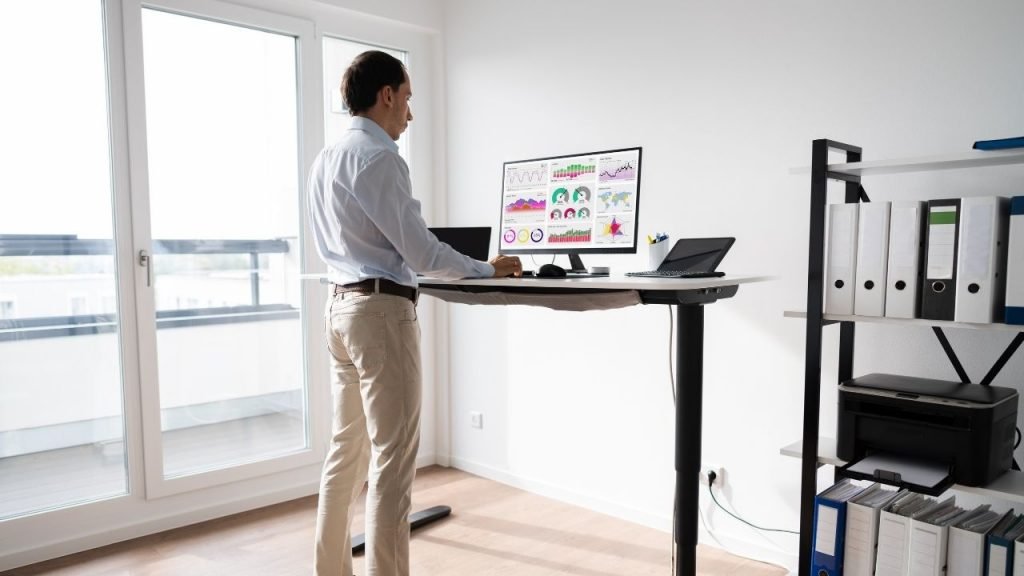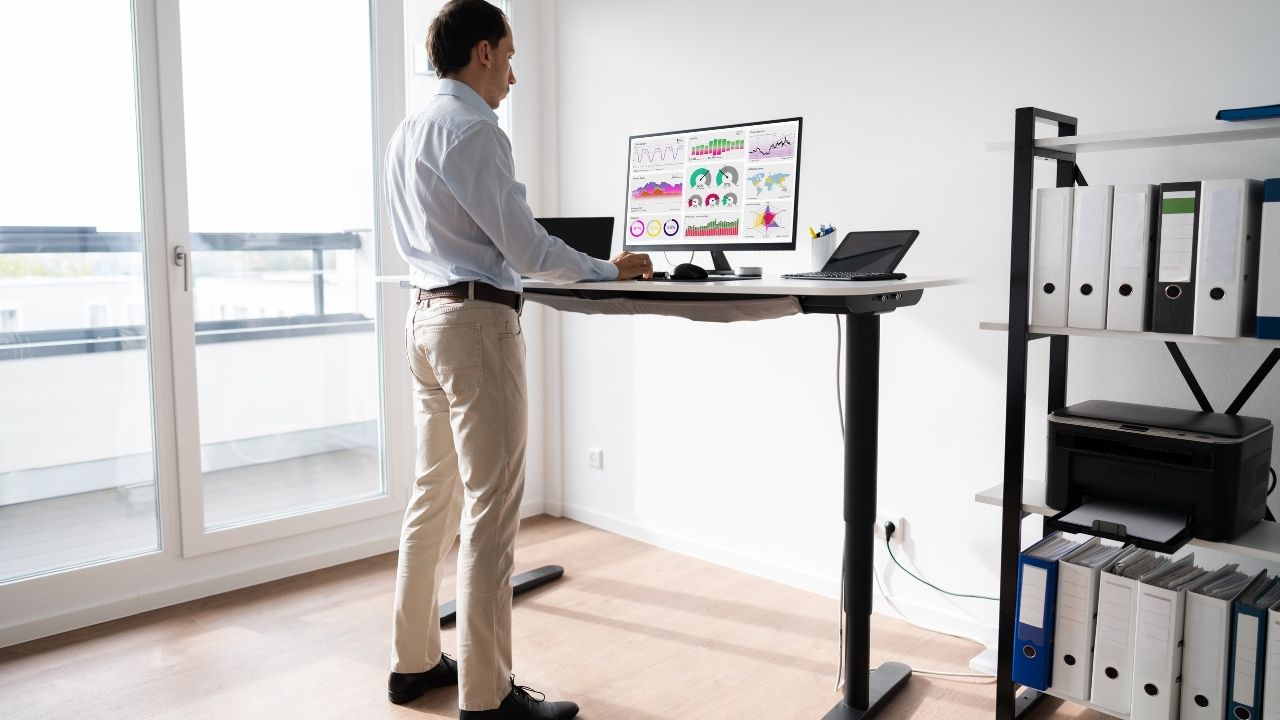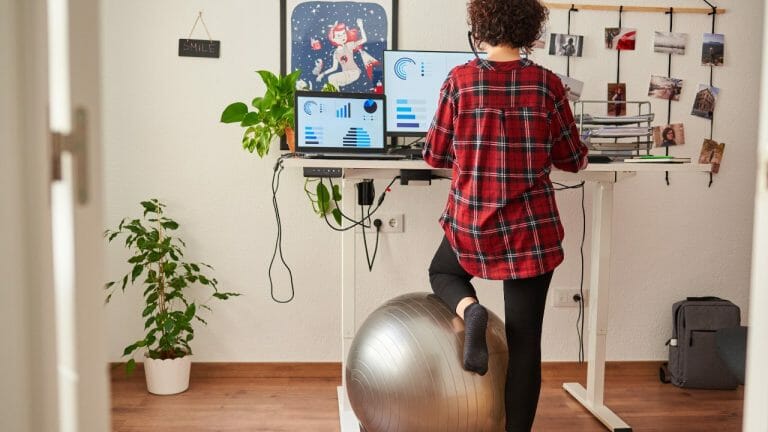Standing Desk Shakes When Typing: What To Do?
You are living your dream life with an electronic standing desk in your office. But the joy turns into despair once it starts to shake. Honestly, it’s not even a rare case. Lots of people have faced a shaky desk when they try to do simple tasks like typing. So, why does it happen?
One major reason behind a shaky standing desk can be improper weight distribution or loose bolts. Incorrect assembly of the parts leads to a wobbly desk frame. You can either take the matter into your hand or call a professional to tighten up the frame for you.
Either way, it requires quite some time. So, the best way to save some of that energy is to learn how to inspect this issue and the right way to fix it.
Is It Normal For Standing Desks To Shake?
Since the introduction of sit-stand desks, users have wondered whether they will stay firm or not. And unfortunately, we have been brainwashed to believe that standing desks do wobble. But that’s not the truth. Yes, we admit there might be certain technical errors that can lead to a shaky desk. Even in that case, it’s not the norm.
The purpose of any desk, be it traditional or ergonomic, is to secure your objects. There’s no point in having a desk if your devices aren’t safe on it. So, does your brand-new desk starts wobbling while you increase the height? Well, you might have chosen a cheap or duplicate desk.
Why Does My Standing Desk Shake?
Your standing desk might have reached its expiry date. Check the warranty card to guess whether the issues are due to its old age or not. If yes, then don’t bother inspecting the standing desk. Instead, focus on replacing the whole unit. However, if that’s not the case, here is a list of reasons why your new desk might be shaking.
1. Loose Bolts
When your top-notch standing desk starts wobbling uncontrollably, the first instinct is to blame the loose bolts. That’s right. Every standing desk you order comes in a small package to make shipment easier. You are supposed to connect each part and build the whole structure. Luckily, every bolt/screw you would need is packed in a small box. There are even markings or labels to identify which one goes where.
Despite all these facilities, you can fail to tighten the bolts securely. Sometimes, we rely on our hand way too much. But in reality, there’s more scope for tightness after our manual installation. If you don’t use torque wrenches, loose or wobbly frames will be the ultimate outcome.
2. Cheap Glides
Glides are found in the junction between two desk columns or legs. When one part goes into another, a lubricated glide makes sure they snug tightly. as a result, you can enjoy a seamless finish. However, the glides need to have good quality to serve this purpose. Otherwise, the columns won’t fit each other like gloves. And, the more you force, the increase in friction will further ruin the glide’s efficiency.
Another reason can be natural wear & tear. If you have been using the desk for too long, regular height adjustment might have caused the glides to give up. The lubrication applied on the glides might dry up due to less maintenance. Make sure you bring a professional to inspect this issue deeply.

3. Uneven Legs
Uneven legs are the result of incorrect measurement during the installation. You were supposed to measure the same length in both desk legs. But the modern ones come with a pre-marked frame. It’s pretty hard to miss it.
So, the most relevant assumption is an uneven floor causing the legs to misalign. When you place heavy furniture on a floor for long period, it’s natural to notice some dents here and there. That leads the desk to have uneven legs. As you see, there’s nothing wrong with the desk itself. Check out our solution section to learn how to fix it.
4. Unbalanced Weight
Nobody talks about how important weight distribution is. To be honest, every standing desk becomes susceptible to wobble in its highest position. It becomes even worse if you have placed heavy items on one end only.
For example, your monitor, speaker, printer, or lamp is situated on one side. While the other side is used for organizing paperwork like files. The weight is unbalanced here. Of course, the weight of multiple files can never be equal to a single device on the other desk. It causes the desktop to shake when you type or write.
5. Wrong Desktop
Last but not the least, the problem might not be with the desk frame at all. Sometimes, a wrong choice of table-top can cause such issues. Here’s how you test it. Take a glass of water and place it on top of the desk. Now, adjust the height of the desk by pressing the “up” arrow. As the desk rises, observe the water inside the glass. Is the water still? If yes, then there’s nothing wrong with your desk frame or structure.
Again, do the same test. But this time, don’t increase height. Instead, hold the desk in one position and start writing/typing. At the same time, check the water’s condition. If the tabletop was an issue, you would notice the water trembling inside the very still glass. That’s your cue to suspect the desktop you used to cover the desk.
You see, not every desk material is suitable for heavy loads. If you picked the cheaper material while dumping heavy devices on top of it, you know what actually happened. The desktop just didn’t have the capacity you required.
How To Stabilize A Shaky Standing Desk
Stabilizing a desk requires you first to identify what the actual issue is. Each reason has a different solution. Once you identify that, pick the solution most suitable for you.
1. Reassemble
The only way to fix the loose screws or bolts within a desk is to reassemble the unit altogether. Now, we won’t suggest you undertake the entire project by yourself mostly because one small mistake can ruin all your efforts. So, it’s best to ask for support while ordering the desk.
However, if you do decide to carry on the project by yourself, here are our tips to follow. Make sure you follow the manual very precisely. Most of the time, the package would include all the necessary screws. Carefully check which screw belongs where before assembling a part. This small step goes a long way.
Also, double-check whether the parts are tightly secured or not. Here’s the right way to tighten screws in a desk frame. First, hand tight it as much as you can. Once your strength runs out, use a tool to do the rest. Again, manually check whether the frame is tightly connected or not. you can never go wrong with manual inspection. Keep that in mind.

2. Stay Within The Weight Limit
It is a must to stay within your standing desk’s weight limit. The capacity is usually 150 to 500 pounds. But one mistake we all make is assuming the tabletop weighs nothing. You see, when you order a heavy desktop made of wood, it weighs a lot. That significantly lowers the remaining weight capacity. For example, a standing desk is advertised to carry 200 pounds in its highest position.
Now, you ordered a light tabletop weighing around 3 lbs per sq ft. On the other hand, there’s another desktop as heavy as 13 lbs per sq ft. It is a no-brainer that the second one is going to be much heavy no matter what shape the table is.
That also means, with the first tabletop, you can put more items on it. But you don’t have the privilege of the second one. All thanks to the weight of the table itself. So, that misconception needs to end. Depending on the table’s material and design, its weight capacity also varies.
3. Cross-Support
An easy way out from a wobbly experience is getting a cross-bar for your standing desk. Cross support is available for every size of desk you own. If you don’t know what a cross-support is, it is attached to the desk legs to provide some extra support and firmness. As a result, the desktop doesn’t shake even in the highest position.
Then why is it not included in every model? Well, the problem arises when you are a taller person. Your requirement for legroom is much higher than an average person’s. Since the cross-support stays under the desktop, it takes away the essential amount of space. Hence, you have no other way but to deal with a cramped space underneath the desk. If you work for too long, your legs might end up aching.
But that only happens when you try to sit, right? If you spend most of the time standing, having a cross-bar is definitely ten times better. A little investment would quickly stabilize your standing desk. Isn’t that amazing?
4. Synchronize The Desk
Sometimes, the standing desk might show internal trouble. By that, we mean there might be something wrong with the controller. In that case, resetting the standing desk works best. No, you don’t have to bring a mechanic home for that. Here’s how to do it.
First of all, press the “down” button. Keep pressing it until the standing desk reaches its lowest point. Now, leave the button for 10-20 seconds. Then, press the button again. This time, you will see the table moves a bit upward before slowly going into the “resting” mode. If you have a display on the desk, it should say, “reset is done.”
Now, what benefits can you enjoy from this? First of all, any data regarding “standing or sitting height” would be gone from the memory. That’s a good thing. Because now, you can manually change it to your preference without confusing the desk.
Plus, if there was any technical glitch inside the desk causing such wobbliness, that would be removed as well. Overall, it’s a good method to stabilize your standing desk.
5. Fix The Floor
Is it tedious to level up an uneven floor? Yes, it is. But it’s certainly not difficult. All you have to do is identify the perfect method suitable for your flooring type. For example, if it’s a cement floor. Just mix a compound and pour it into the dip or crack. Soon, the mixture will dry up, giving you a smooth finish.
Or, if you have a wooden floor, the process will be slightly longer. You have to open up the wooden slabs first. After that, just look for the slop or slant within the underlayment. Once you locate it pour the mixture as we instructed earlier. Once the underlayment levels up, attach the wooden slabs again. Viola! You have fixed the uneven floor.
Now, place your standing desk on it. Check whether the shakiness has gone or not. If you still don’t get a firm result, then the reason might have been something else all along.

Which Standing Desks Are Less Wobbly Or Shaky?
When you are in the market shopping for a standing desk, you should check certain factors. For example, it’s best to invest in a heavy frame or legs. Heavier frames have the tendency to be better supporters. Hence, you barely need to face any wobbliness while typing.
One way to check out which desks have heavier frames is to look for their weight capacity. Yes, strong frames can carry more weight without shaking. This formula works every time. Let’s say you come across two standing desks with 200 pounds and 300 pounds weight limits. Which one would you consider stronger? Of course, the second one.
However, if you are one of those people who blame every electronic standing desk for shaking, you should find a manual one. Sometimes the old way is the best way. We are talking about the pneumatic ones. Yes, the ones with a manual crankshaft. Some users find the pneumatic desks more stable. So, you can go that way as well.
Before You Go!
After everything you have gone through to fix a standing desk, you might question its worth. That’s understandable. Some people go to the extent of switching to a desk riser instead of investing in a full-fledged standing desk. If you want a change in your workplace, you can sure do that too.
But before that, check our article on standing desk vs desk riser to learn the basic differences.


![How Do You Clean A Flexispot Desk? [Maintenance Guide]](https://homethereby.com/wp-content/uploads/2022/09/1-wide-1-vertical-monitor-setup-768x432.jpg)
![Is Standing Desk Better For Posture? [4 Better Posture Guide]](https://homethereby.com/wp-content/uploads/2022/07/How-Much-Should-You-Spend-On-A-Standing-Desk-2-768x432.jpg)
![How Long Do Flexispot Desks Last? [Honest Explanation]](https://homethereby.com/wp-content/uploads/2022/10/flexispot-e8-768x765.jpg)

![Do Standing Desks Build Muscle? [Real Examples]](https://homethereby.com/wp-content/uploads/2022/02/How-Thick-Should-A-Standing-Desk-Top-Be-768x432.jpg)